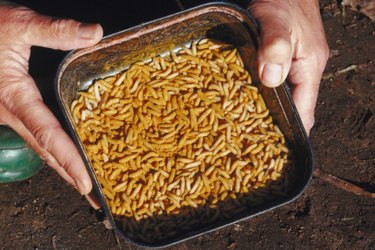Things You'll Need
Beneficial parasitic nematodes
Root maggot insecticide
3 hot peppers
3 cloves garlic
1 onion, chopped
Blender
3 cups water
1 tablespoon liquid dishwashing soap
Strainer
Garden tiller
Toilet paper rolls
Floating seed row covers
Large rocks

Maggots in the soil, also known as root maggots, are harmful to garden plants. They are drawn to moist and rich soil, like the soil used when transplanting seedlings or preparing the soil for seed sowing. Removing maggots in the soil is a two-part process. Gardeners must kill existing maggots, then take steps to prevent further infestation. There are chemical and natural methods of killing maggots in the soil.
Step 1
Purchase beneficial parasitic nematodes from your local garden center. Apply the nematodes to the soil according to the directions on the package. Apply the nematodes in the early or mid-summer.
Video of the Day
Step 2
Apply a registered root maggot insecticide to the soil according to the package directions.
Step 3
Apply a hot pepper treatment to the soil instead of the insecticide, if you prefer a more natural method of killing the maggots. Add 3 hot peppers, 3 cloves of garlic, and a chopped onion to a blender. Pour in 1 tablespoon of liquid dish soap and 3 cups of water. Blend until smooth.
Step 4
Let the blended mixture sit for 24 hours, then pour it through a strainer and into a jar. Pour the mixture directly onto the affected areas of the soil.
Step 5
Till the garden plants into the soil at a depth of 8 inches with a garden tiller immediately after you harvest the vegetables, or after the flower's growing season ends. This will prevent the maggots from overwintering in your plants.
Step 6
Slip empty toilet paper rolls around the base of your seedlings when you plant them the next spring. These will act as plant collars and prevent the adult flies from laying eggs around the base of your plants.
Step 7
Cover newly planted rows with floating row covers. Use large rocks to anchor down the edges of the row covers.
Video of the Day